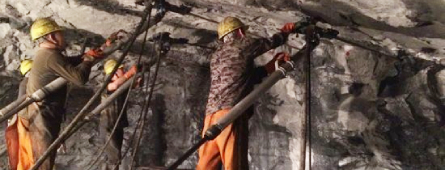How to Choose Tapered Drill Bit and Tapered Drill Rod
Dec 06, 2024
1. Classification of Tapered Drill Bit
1.1 Three main tapered drill bits: chisel bit, cross bit, button bit.
Commonly used taper:7°、11°、12°, while 4.8°、6°、9° are also available
Chisel Bit: The chisel bit is suitable for light-duty rock drills, drilling rock holes with a diameter of less than 50mm, and is suitable for rocks with low hardness. The drill bit is widely used in various mines such as coal, iron, gold, copper, lead and zinc, as well as tunnel excavation in railway, highway and water conservancy construction.

Cross Bit: The taper cross bit is suitable for high-power rock drills and can drill into complex rock formations such as rock cracks. Has strong radial wear resistance. The cross drill also adopts mature technology, high-quality steel and alloy, strong radial wear resistance, high production efficiency and controllable cost.

Button Bit: Tapered button bits are suitable for dry and wet drilling in medium and hard rock. Mainly used for various mines, transportation, water conservancy, roadway, tunnel excavation, quarrying and rock breaking projects in municipal construction.
1.2. Tapered Drill Rod
 Integrated Tapered Drill Rod:These bit is actually the bit and the drill steel all in one piece. The shank which goes into the drill, the body of the steel, and a silver brazed carbide tip. The body of the drill steel is actually smaller than the bit to allow cuttings to travel up and out of the hole.
Integrated Tapered Drill Rod:These bit is actually the bit and the drill steel all in one piece. The shank which goes into the drill, the body of the steel, and a silver brazed carbide tip. The body of the drill steel is actually smaller than the bit to allow cuttings to travel up and out of the hole.  Tapered Drill Rod:Tapered drill rods can be used with tapered button bit as part of a drilling machine. It connects with the same taper as the drill (7', 11', 12'). When the tapered drill bit is worn out due to drilling work, it can be replaced with a new tapered drill bit, so that the tapered drill rod can be used for a long time without damage, which is economical.
Tapered Drill Rod:Tapered drill rods can be used with tapered button bit as part of a drilling machine. It connects with the same taper as the drill (7', 11', 12'). When the tapered drill bit is worn out due to drilling work, it can be replaced with a new tapered drill bit, so that the tapered drill rod can be used for a long time without damage, which is economical.2. How to Choose Tapered Drill Bit and Tapered Drill Rod
Different rock formations and rock drills require different cone angles. Wide cone angles are often used when drilling with high impact hydraulic rock drills in moderately hard to hard and abrasive rock formations. Modern drill rigs typically use 11 and 12 taper angles. For low impact rock drills and softer rock formations, use a narrow taper angle of 7. The 7 angle can also be used if you have problems with the bit rotation when using the 11 and 12 equipment. Also, the 4.8 angle is perfect for soft rock when using a pneumatic or hydraulic drill to prevent the bit from spinning or falling off. A single drill pipe is used to drill short holes (≤2.0m), while a drill pipe that can be connected is used to drill deeper holes (>2.0m) to avoid excessive bending stress.
When choosing a rock drilling bit, it should be selected according to the type, performance, rock hardness and toughness of the bit. Generally, a slotted bit is used when there is no crack in the rock; the cross drill bit can be widely used in various rocks, especially hard and extremely hard rocks with high abrasive cracks; the spherical tooth bit is suitable for all kinds of rocks except for highly abrasive rocks. kind of rock.
The following table is for reference only
| Chisel Bits | Cross Bits | Button Bits | ||
| Taper Degree | 7° | 7°, 11°and 12° | 7°, 11°and12° | |
| Bits Socket Diameter | mm | 23 | 23 | 22 |
| inch | 27/32 | 27/32 | 7/8 | |
| Bit Diameter | mm | 26 ~ 43 | 28 ~ 51 | 28 ~ 45 |
| inch | 1 1/32 ~ 1 45/64 | 1 7/64 ~ 2 | 1 7/64 ~ 1 25/32 | |
|
Remark
|
There are horseshoe and oblique chipways designs; To drill media hard, hard and crack not grown formation with rock hardness not above f15 and in place where the compacting power of the rock drill doesn’t exceed 8Kg/Mpa |
To drill hard, very hard and crack grown formation | There are short skirt average long skirt and enhanced long skirt; with hemi-spherical or parabolic inserts configurations; to drill all rock formations except very hard and abrasive formations | |

















.png)


